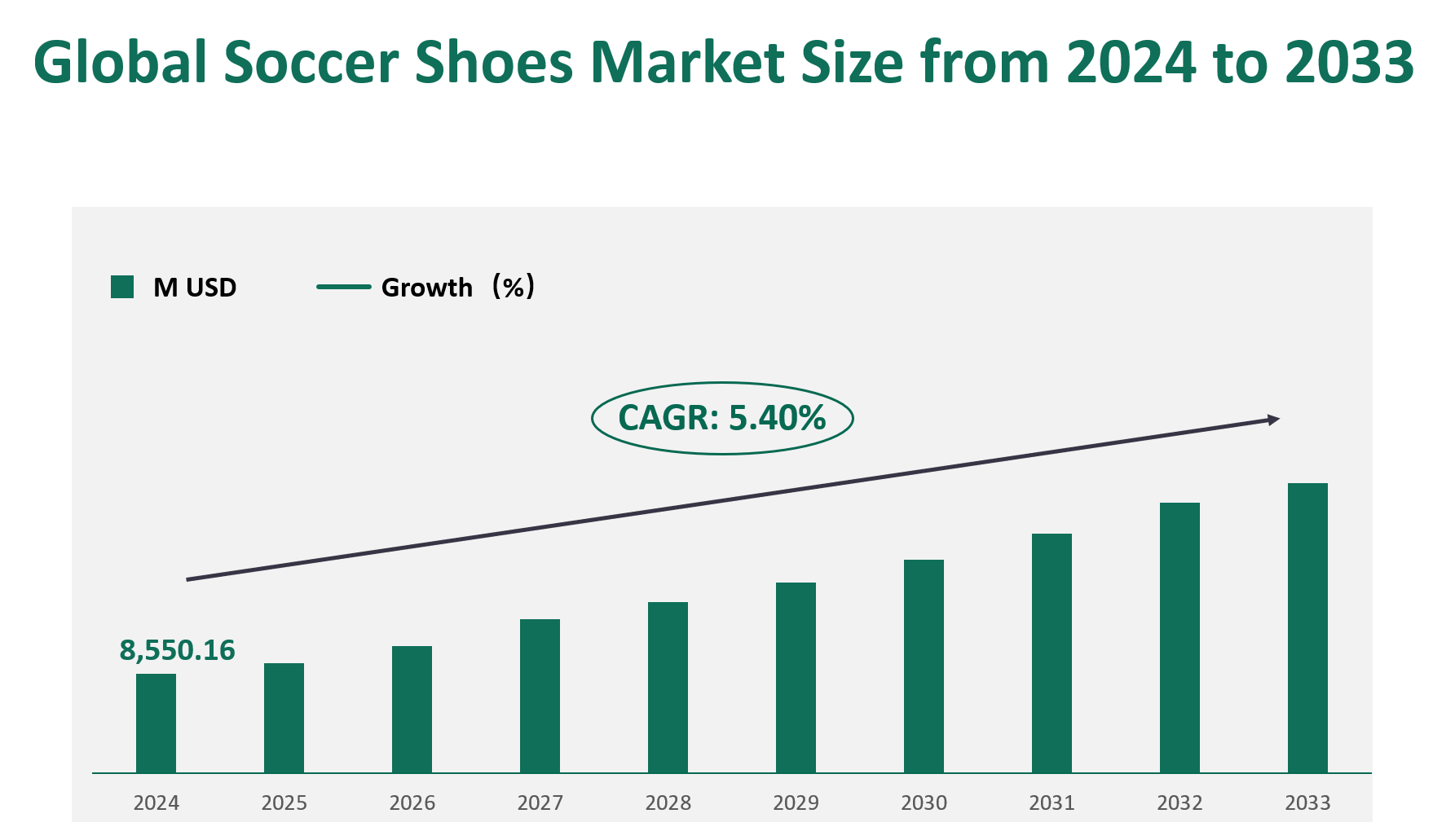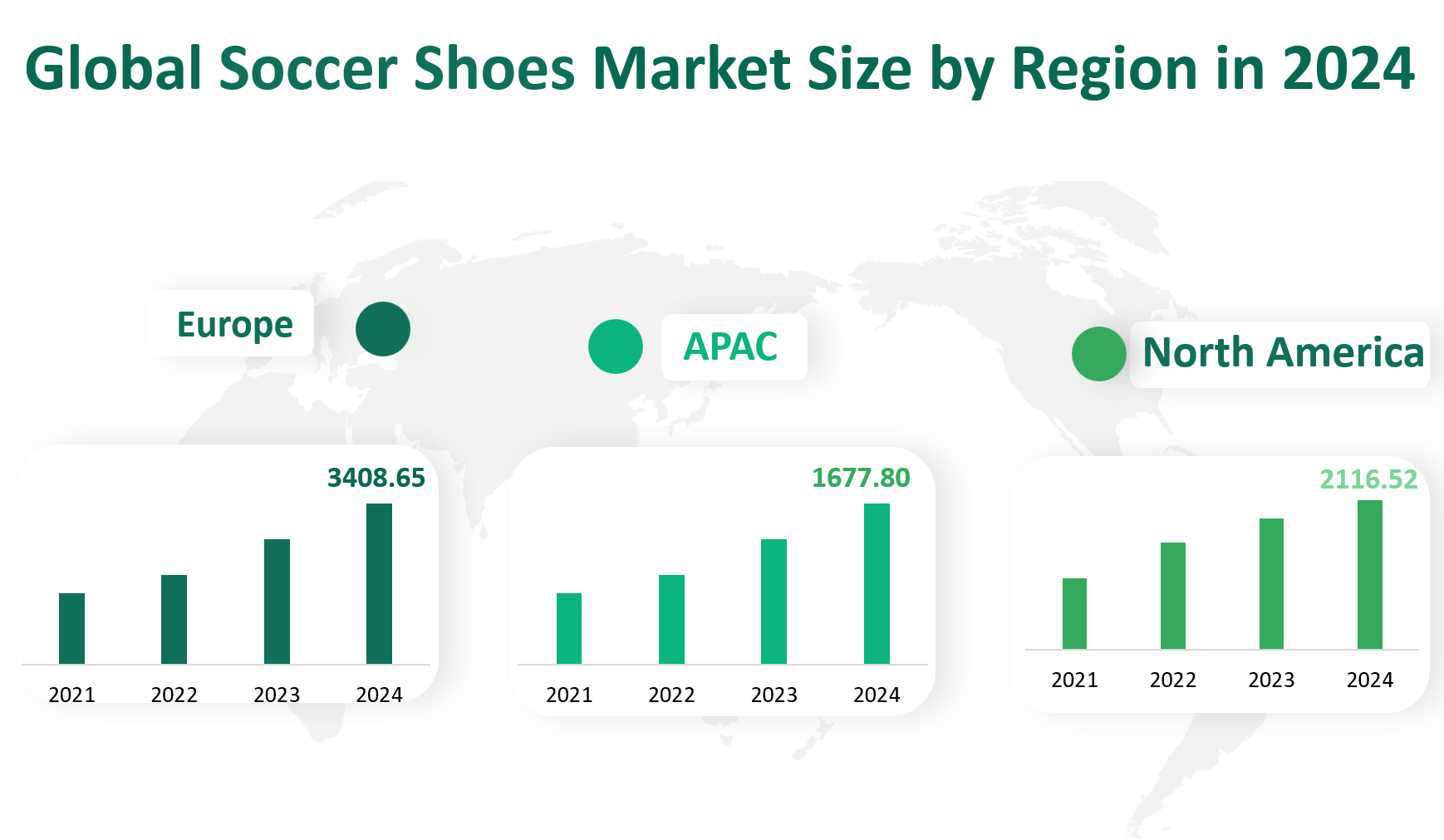1. Global Soccer Shoes Market Insight Analysis
The global soccer shoes market continues to exhibit significant growth, with a market value reaching $8,550.16 million in 2024, with a Compound Annual Growth Rate (CAGR) of 5.40% from 2024 to 2033.
Soccer shoes, also known as football boots, are specialized footwear designed specifically for playing soccer. These shoes are engineered to provide optimal traction, support, and comfort on various playing surfaces, including natural grass, artificial turf, and indoor courts. The design of soccer shoe includes key features such as cleats or studs on the outsole for better grip, lightweight and breathable materials for enhanced performance, and ergonomic shapes to fit the foot comfortably.
The importance of soccer shoe extends beyond mere functionality; they also play a crucial role in injury prevention by providing stability and support during rapid movements and direction changes. The market for soccer shoes is segmented into two main categories: men’s soccer shoe and women’s soccer shoe. Each category is tailored to meet the specific needs of its target audience, with differences in size, fit, and design to accommodate the unique biomechanics of male and female players.
Figure Global Soccer Shoes Market Size (M USD) and CAGR (2024-2033)

2. Driving and Limiting Factors of Soccer Shoes Market Growth
The growth of the global soccer shoe market is influenced by a variety of factors. On the positive side, the increasing popularity of soccer as a sport worldwide is a major driver. Soccer is the most widely played sport globally, with a massive fan base and participation levels that continue to rise. This surge in interest has led to a higher demand for specialized soccer shoe, particularly among amateur and professional players.
Additionally, the growing awareness of the importance of proper footwear in enhancing performance and preventing injuries has further fueled the market. Technological advancements in shoe design and materials have also played a significant role. Modern soccer shoes are now lighter, more comfortable, and offer better traction and support than ever before. Companies are continuously investing in research and development to innovate and improve their products, which has broadened the appeal of soccer shoe to a wider consumer base.
However, the market also faces several challenges. One of the primary limiting factors is the high cost associated with premium soccer shoe. High-performance models, often made with advanced materials and technologies, can be prohibitively expensive for many consumers, particularly in developing countries. This can limit market penetration and restrict overall growth. Another challenge is the fluctuating demand due to economic conditions. During economic downturns, consumers may prioritize essential purchases over luxury items like specialized athletic footwear. Additionally, the market faces competition from generic or counterfeit products that offer lower prices but may not meet the same quality standards. These products can erode market share and consumer trust in the long run.
3. Technology Innovation and Corporate Mergers and Acquisitions in Soccer Shoes Market
Technological innovation has been a cornerstone of the soccer shoe market. Manufacturers are constantly exploring new materials and design concepts to enhance performance, comfort, and durability. For example, the use of advanced synthetic materials and lightweight fabrics has become increasingly common. These materials not only reduce the weight of the shoes but also improve breathability and moisture-wicking capabilities, ensuring that players remain comfortable even during intense matches. Additionally, advancements in sole technology have led to the development of multi-surface studs and cleats that can adapt to different playing conditions. This versatility allows players to switch between different surfaces without needing multiple pairs of shoes.
Corporate mergers and acquisitions have also shaped the market landscape. Major players like Nike, Adidas, and Puma dominate the global soccer shoe market, and they often engage in strategic partnerships or acquisitions to expand their product portfolios and market reach. For instance, Nike’s acquisition of smaller brands has allowed it to tap into niche markets and leverage new technologies. Similarly, Adidas has focused on integrating sustainable materials into its product lines, aligning with global trends towards eco-friendly products. These strategic moves not only enhance the companies’ competitive positions but also drive innovation and market expansion.
4. Global Soccer Shoes Market Size by Type
Soccer shoes are specialized footwear designed to enhance performance and provide stability on various playing surfaces. The two primary product types in the soccer shoe market are Woman Shoes and Man Shoes.
Woman shoes are designed with the unique biomechanics of female players in mind. These shoes typically feature a narrower fit, lighter weight, and more flexible materials to accommodate the specific movements and playing styles of women. In terms of design, woman soccer shoes often incorporate vibrant colors and patterns that appeal to female consumers. The revenue generated by woman shoes in 2024 is projected to be $2293.90 million.
Man shoes are designed to meet the demands of male players, who generally require more robust and supportive footwear due to their larger foot size and more aggressive playing style. These shoes often feature sturdier materials, deeper cleats for better traction, and enhanced stability features. The market revenue for man shoes in 2024 is $6,256.27 million.
Table Global Soccer Shoes Market Size by Type in 2024
5. Global Soccer Shoes Market Size by Application
The soccer shoe market can be segmented based on its applications, which primarily include Amateur and Professional use.
Amateur soccer shoes are designed for recreational players who participate in soccer for fun, exercise, or local competitions. These shoes prioritize affordability, comfort, and basic performance features. They are typically made from more cost-effective materials and have simpler designs compared to professional-grade shoes. The market value for amateur soccer shoe in 2024 is projected to be $6,623.01 million.
Professional soccer shoes are engineered for elite athletes who compete at the highest levels of the sport. These shoes incorporate advanced technologies, such as lightweight materials, enhanced traction systems, and customized fit options, to optimize performance on the field. Professional soccer shoes often come with a higher price tag due to their superior quality and specialized features. In 2024, the market value for professional soccer shoe is forecasted to be $1,927.15 million.
Table Global Soccer Shoes Market Size by Application in 2024
Application | Market Size (M USD) 2024 |
Amateur | 6623.01 |
Professional | 1927.15 |
6. Global Soccer Shoes Market by Top Regions
North America is a significant market for soccer shoe, driven by the popularity of soccer in the United States and Canada. In 2024, the market value for soccer shoe in North America is projected to reach $2,116.52 million.
Europe is the largest regional market for soccer shoes, with a projected market value of $3,408.65 million in 2024. The region’s rich soccer heritage, professional leagues, and high demand for high-quality sports equipment contribute to its dominant position.
The Asia-Pacific region is the fastest-growing market for soccer shoe, with a projected market value of $1,677.80 million in 2024. The region’s growth is driven by increasing participation in soccer, rising disposable incomes, and growing awareness of sports and fitness.
South America is known for its passionate soccer culture and high demand for soccer shoe. In 2024, the market value for soccer shoes in South America is projected to be $981.54 million. The region’s growth is driven by the popularity of professional soccer leagues and the increasing participation in amateur soccer.
The Middle East and Africa region is a growing market for soccer shoes, with a projected market value of $365.65 million in 2024. The region’s growth is driven by increasing investments in sports infrastructure, rising participation in soccer, and growing consumer demand for sports equipment.
Figure Global Soccer Shoes Market Size by Region in 2024

7. Global Soccer Shoes Market Analysis by Major Players
7.1 Nike
Introduction and Business Overview Nike is an American multinational corporation and the world’s largest supplier of athletic shoes and apparel. Founded in 1964, Nike is headquartered in Beaverton, Oregon. The company is renowned for its innovative products, marketing strategies, and global presence.
Products Nike offers a wide range of soccer shoes, including models designed for different playing surfaces and skill levels. Popular lines include the Nike Phantom, Nike Mercurial, and Nike Tiempo series. These shoes are known for their advanced technologies, such as Flyknit uppers, Dynamic Fit collars, and specialized traction patterns.
7.2 Adidas
Introduction and Business Overview Adidas is a German multinational corporation and the largest sportswear manufacturer in Europe. Founded in 1949, Adidas is headquartered in Herzogenaurach, Germany. The company is known for its high-quality products, innovative designs, and strong brand presence globally.
Products Adidas offers a variety of soccer shoes, including the Predator, X, and Copa series. These shoes are designed to meet the needs of professional and amateur players, with features such as Primeknit uppers, Continental rubber outsoles, and adaptive fit technologies.
7.3 Puma
Introduction and Business Overview Puma is a German multinational corporation and the third-largest sportswear manufacturer in the world. Founded in 1948, Puma is headquartered in Herzogenaurach, Germany. The company is known for its stylish and high-performance products, targeting both professional athletes and casual consumers.
Products Puma offers a range of soccer shoes, including the Ultra, Future, and King series. These shoes are designed with advanced technologies such as evoKNIT, MATRYXEVO, and Pebax outsoles, providing superior comfort, fit, and performance.

